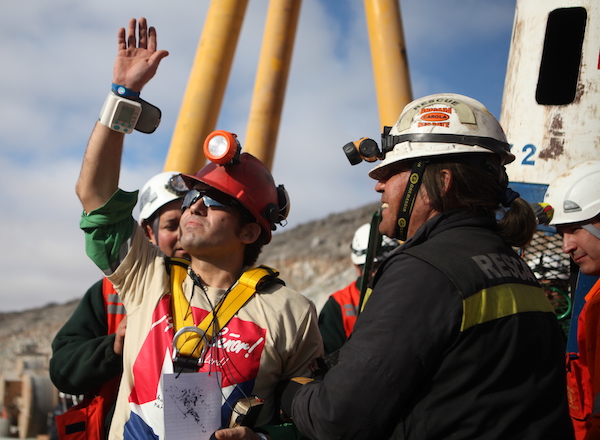IBM steps up efforts to help miners improve health and safety records


In 2010, a mine in northern Chile collapsed, trapping 33 workers underground for more than two months. IBM is working to provide AI solutions that can improve response to mine disasters. (Image: Miner Alex Vega. Hugo Infante, Chilean Gov't via Wikipedia.)
Much has been said lately about how IBM's cognitive exploration and content analysis platform, known as Watson, is helping major miners, such as Goldcorp and Newcrest, in a number of ways, from mine planning and operational performance optimization to sharpening takeover strategies.
A less touted, but equally helpful advantage of this and other artificial intelligence (AI) applications is the role they are playing - or expected to play- in the health and safety area of mining companies.
For Mark Fawcett, a partner with IBM Global Business Services, the answer is clear. Available technologies, he tells MINING.com, go beyond helping mining companies predict when their equipment is going to fail, they can also monitor biometric and environmental data to identify whether employees are at risk of danger.
Data can be gathered in near real time from wearables, smart devices, and environmental sensors to help firms respond to problems or react to changing environmental conditions.
The problem is that many organizations do not have an automated safety system in place, Fawcett says. Often, they are paper-based or rely on systems where the data is unstructured. Even when there are systems in place, they usually vary from mine to mine. Ultimately, safety departments are left with an incomplete view of incidents across their organization.
"AI has the ability to quickly consume the data regardless of source and easily provide insights on the top issues, major trends that are occurring, and share insights on data that may have been missed. In addition, historical data can be consumed to trend historically over time," Fawcett notes.
IBM believes that in the "very near" future, AI will provide a full analysis on working conditions before an employee even takes a work order.Fawcett believes that in the "very near" future, AI will provide a full analysis on working conditions before an employee even takes a work order. This will include a complete summary on where the task is going to be performed spatially, forecasted weather data and relevant safety notices for the worker in that specific location.
"The freeze-thaw cycle is a common example of where we can apply spatial analytics to safety. When an employee receives a work order where the ground may be frozen, that work order would be accompanied by the relevant safety notices and other events that have happened giving the employee a relevant picture of the work, the forecast and potential risk," he says.
"Using this data, we can prevent a lot of falls that would have otherwise happened without that notice, ultimately resulting in smarter and safer working conditions."
That's why IBM is developing what it calls "Watson safe", currently in its second phase and is expected to be ready on a platform scale in the second half of the year.
Wearable safety
IBM is also working on extending the reach of the so-called internet of things (IoT), a system of interrelated computing devices, mechanical and digital machines, objects, people and even animals embedded with sensors, software, electronics and connectivity. These allow the system to perform better by exchanging information with other connected devices without requiring human-to-human or human-to-computer interaction.


Image: Shutterstock.
The company has recently joined wearable technology developer Garmin to offer organizations who deploy IBM's Maximo Worker Insights platform to receive alerts based on near real-time sensor data from workers wearing Garmin activity trackers.
By embedding the Garmin Health Companion SDK in the IBM Maximo Worker Insights platform, supervisors and safety officers can receive notifications for high heart rate and man-down scenarios, as well as review historical analytics based on the biometric signals from Garmin wearables.
The IT giant is also partnering with Guardhat, Mitsufuji and SmartCone to help monitor worker safety in hazardous environments.
Guardhat's KYRA IoT platform can complement the IBM Worker Insights solution to provide situational awareness to workers and company operations through the use of Smart PPE wearables.
Mitsufuji, in turn, has launched a new wearable "shirt" made from silver conductive fibres that tracks data from workers' biometrics to help ensure safety in extreme environments.
SmartCone, a provider of smart, IoT-based safety and monitoring solutions for securing vulnerable and hazardous zones, will be integrating Maximo Worker Insights into its highly portable system to monitor worker safety in the utilities industry, community traffic, construction, mining and industrial environments with moving or dangerous no-go zones.
Response to mine disasters
IBM envisions AI being used also to improve response to mine disasters. When something like the recent deadly dam disaster in the Brazilian town of Brumadinho happens, everyone from national government leaders and the military to the small-town mayor and scores of volunteers come together to respond to the event. All those people, at every level, need to communicate, share information and coordinate their activities so that they're doing things efficiently and not duplicating their efforts.
Many times, that doesn't happen effectively because people can't find or share the information they need, when they need it.
IBM is already supporting Lightship, a company that offers an intelligent fields operations tool to help organizations navigate their data to find the necessary information to help them make better, safer decisions. It pulls together all of an organization's information, such as Geographic Information System (GIS) mapping, drone photos, satellite photos and the real-time locations of people and vehicles.